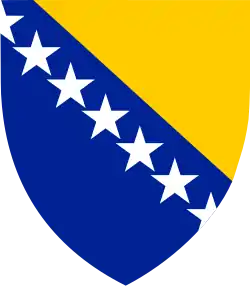Canton 10
Herzeg-Bosnian Canton (Croatian: Hercegbosanska županija) is one of the ten cantons of the Federation of Bosnia and Herzegovina, a political entity of Bosnia and Herzegovina. It is the largest canton by area and eighth by population. The local government seat is in Livno, while the assembly is in Tomislavgrad.
Herzeg-Bosnian Canton Herceg-bosanska županija | |
|---|---|
 Flag
 Coat of arms
| |
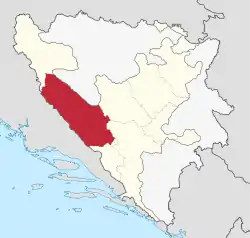 | |
| Status | Canton of the Federation of Bosnia and Herzegovina |
| Capital | Livno (executive) Tomislavgrad (legislative) |
| Largest city | Livno |
| Official languages | CroatianSerbianBosnian |
| Ethnic groups (2013[1]) | 77.05% Croats 13.01% Serbs 9.58% Bosniaks |
| Government | Parliamentary system |
| Ivan Vukadin (HNP) | |
• President of Assembly | Jozo Ćosić (HDZ 1990) |
| Legislature | Assembly of Canton 10 |
| Canton of the Federation of Bosnia and Herzegovina | |
• Establishment | 12 June 1996 |
| Area | |
• Total | 4,934.9 km2 (1,905.4 sq mi) |
| Population | |
• 2013 census | 83,844 |
| GDP (PPP) | 2022 estimate |
• Per capita | USD 14.983 |
| GDP (nominal) | 2022 estimate |
• Total | USD 155.642 Million |
• Per capita | USD 5.762 |
| HDI (2019) | 0.740 high |
| Currency | BAM |
| Time zone | UTC+1 (CET) |
| UTC+2 (CEST) | |
| Date format | dd-mm-yyyy |
| Driving side | right |
Website vladahbz | |
The canton was established in 1996, in accordance with the Washington Agreement of 1994, which ended the Croat-Bosniak War. The majority of the population is ethnically Croat, living in the southern part of the canton, while the second-largest Serbs live in the northern part.
During the Bosnian War, the Croatian Defence Council (HVO) controlled the southern parts of the canton, while other parts, mostly in the north, were controlled by the Serb Army of Republika Srpska until 1994 when they were re-taken by the HVO with the support from the Croatian Army. In accordance with the Washington Agreement, the territories were incorporated into the Croat-Bosniak Federation of Bosnia and Herzegovina. From 1996 to 2005, only Croats and Bosniaks were considered to be constituent nations within the canton, but since 2005, the Serbs are included among the constituent nations as well and are mentioned as such before the less numerous Bosniaks.
Name, symbols and language
In Croatian, the term županija is used, while in Serbian and Bosnian, the term is kanton/кантон. The canton is officially referred to by the Federation of Bosnia and Herzegovina as Canton 10 (Kanton 10 or Županija 10).[2] The local government refers to it as the Herzeg-Bosnia County, in Croatian Hercegbosanska županija, and uses that name in the local constitution.[3][4] This name was declared unconstitutional by the Constitutional Court of the Federation because the name is a characteristic shared by all the cantons in the sense that all of them are within Bosnia and Herzegovina.[2] Other names used at the national level include North Herzegovina Canton (Sjevernohercegovački kanton, Sjevernohercegovačka županija) and Livno Canton (Livanjski kanton), after its capital.[5][6][7]
The coat of arms of the canton under its constitution is a variant of the historical Croatian coat of arms. The flag is a horizontal tricolour of red, white and blue, with the coat of arms in the middle.[8] These symbols were used by the former Croatian Republic of Herzeg-Bosnia. The West Herzegovina Canton also uses this flag and coat of arms. Their use as the official symbols of the canton was deemed unconstitutional by the Constitutional Court of the Federation, because "they only represented one constituent nation".[2] The local government continues to use the flag and the coat of arms at plates at the official institutions.[9][10]
Since 2005, the constitution lists the "languages spoken by Croats, Serbs and Bosniaks" as the official languages, without naming them, with both the Latin and the Cyrillic script having an equal status.[8]
History
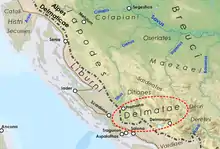
Originally occupied by the Dalmatae, the area of Canton 10 was annexed in 15 AD by the Roman Empire and formed part of the Roman province of Dalmatia. After the introduction of Christianity, Delminium (Tomislavgrad) is the seat of the bishopric.
These years also see the creation of the city of Livno. In 892 was recorded the first written appearance of the name of Livno which was the seat of one of the counties of the Kingdom of Croatia. The region is attached in the ninth century to the Kingdom of the Croats and later in the 14th century to the Kingdom of Bosnia. After the death of the king of Bosnia, Tvrtko I in 1391, the power of the Kingdom of Bosnia gradually declines and the region is taken over by the Kingdom of Croatia, the state associated with the Kingdom of Hungary by a personal union.
In the 16th century, the region was fully integrated for four centuries within the Ottoman Empire. Under the Ottoman Empire, peasants who remained Catholic or Orthodox were hostile to Turkish officials and to Islamised landowners.
In the nineteenth century, several uprisings and rebellions against Muslim authorities erupted in Bosnia and Herzegovina. Suffering under oppression by the authorities and furious after the Muslim authorities had killed the Catholic spiritual leader of this region, Lovro Karaula, Franciscan priest, the Catholics of Livno rose up against Ottoman rule on July 20, 1875. Soon, the Catholics from across the region joined this uprising. The rebel leaders were two Franciscan priests, Stjepan Krešić and Bonaventura Šarić-Drženjak. For three years, the insurgency controlled the mountainous regions of Glamoč, Livno, Kupres and Grahovo. When the Austrian army arrived in the Livno region in 1878, the insurgents handed over their arms to the Austrians. The Austro-Hungarian troops met in this region an opposition, both of the Muslim population and the Orthodox population, fighting battles in the vicinity of Livno. The region is liberated at the end of the summer of 1878.
Austria-Hungary occupied the region militarily and Bosnia and Herzegovina after 1878 Berlin Congress. This period is marked by industrialization and Westernisation. Architecturally, many public buildings were built and many Catholic religious buildings were erected that were banned during the Ottoman era.

After World War I, the area of Hercegbosna county was in the Kingdom of Serbs, Croats and Slovenes, later Yugoslavia. Most of the present-day area of Hercegbosna County belonged to the then-Travnik area in 1922, while the smaller northern parts belonged to the Bišćan area. After the introduction of the January 6 dictatorship and the division of the state into banovinas in 1929, most of the Croatian areas of Hercegbosna county became part of Primorska banovina with headquarters in Split, while the northern Serbian areas were annexed to Vrbas banovina, with headquarters in Banja Luka. With the creation of Croatian Banovina in 1939, all of Primorska Banovina became part of it, including the majority of Croat areas of Canton 10.
After the creation of the NDH and its administrative division, most of the area of today's Hercegbosna County was part of the Great Parish of Pliva and Rama with its seat in Jajce, while the smaller northern part belonged to the Great Parish of Krbava and Psata with its seat in Bihać. After the defeat of the Axis powers in 1945, the area of Hercegbosna County became part of the then-federal unit of SFR Yugoslavia, Bosnia and Herzegovina. During the democratic process, most of the Croatian municipalities in the county, Kupres, Livno and Tomislavgrad, became part of the Croatian Republic of Herceg-Bosna.
With the independence of Bosnia and Herzegovina in the northern and western part of Hercegbosna County under the leadership of the SDS, the Serb majority areas sided with the Army of Republika Srpska killing Croats and Bosniaks in Drvar, Grahovo, Glamoc, attacking Kupres and shelling Livno and surrounding settlements. After the formation of HVO military units, first, the Kupres area was liberated. Croats and Bosniaks formed the Federation of Bosnia and Herzegovina through the Washington Agreement, which included the entire area of Hercegbosna County under HVO control, and a little later, in the summer of 1995, HVO and HV defeated Serb forces decisively. They attacked and captured Grahovo, Glamoč and Drvar, which, together with other victories of the HVO, HV and the RBiH Army, created the conditions for the signing of the Dayton Peace Agreement. After the war, in 1996, Herceg-Bosna self-abolished and FBiH was organized into counties, when Hercegbosna County, the largest county in FBiH, was created.
The Constitution of Herzeg-Bosnia Canton was adopted by the Cantonal Assembly on 19 December 1996.
Geography

The total area of the canton is approximately 4,934 square kilometres (1,910 sq mi), a tenth of the surface of Bosnia-Herzegovina and c. 19% of the Federation.[11] The region is located between Dalmatia to the west, Una-Sana Canton to the north, Central Bosnia Canton to the east and West Herzegovina Canton and Herzegovina-Neretva Canton to the south and southeast.
The natural and geographical features of this area are diverse, ranging from fertile and vast fields and vast pastures, rivers and lakes to centuries-old deciduous and evergreen forests, and provide abundant opportunities for life and economic development based on agricultural production, livestock and the timber industry. The ecologically clean and unspoiled nature, the mild continental climate, the geographical position and the proximity and good transport connections with neighbouring Croatia, i.e. its gateway to the world, Central Dalmatia, and the connection with the whole of Herzegovina, are important factors for economic progress in this area.
Topography
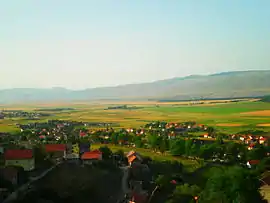
The mountainous terrain of the region is a part of the Dinaric Alps, linked from a fold and thrust belt dating from the late Jurassic period, itself part of the Alpine orogeny, extending southeast from the southern Alps. The Dinarides form part of a chain of mountains that stretch across southern Europe and isolate Pannonian Basin from the Mediterranean Sea. The highest mountain of the Tropolje Dinarides is Mount Vran, located on the border of the municipalities of Tomislavgrad and Jablanica with the peak called Veliki Vran (Great Vran) at 2,074 metres (6,804 ft).
| Highest mountains of Tropolje | |||
|---|---|---|---|
| Mountain | Peak | Elevation | Coordinates |
| Vran | Veliki Vran | 2,074 m (6,804 ft) | 43°40′4.8″N 17°30′18″E |
| Vran | Mali Vis | 2,014 m (6,608 ft) | 43°40′41.34″N 17°29′57.08″E |
| Cincar | Cincar | 2,006 m (6,581 ft) | 43°54′08″N 17°03′46″E |
| Vran | Crno Brdo | 1,966 m (6,450 ft) | 43°40′52.96″N 17°29′37.3″E |
| Vran | Mali Vran | 1,961 m (6,434 ft) | 43°39′8.8″N 17°17′27″E |
| Vran | Bijela Glava | 1,949 m (6,394 ft) | 43°39′34″N 17°29′56″E |
| Vitorog | Veliki Vitorog | 1,907 m (6,257 ft) | 44°7′12″N 17°2′45″E |
| Golija | Veliki Vrh | 1,886 m (6,188 ft) | 43°59′12″N 16°47′21″E |
| Vran | Priorac | 1,881 m (6,171 ft) | 43°39′37″N 17°28′27″E |
| Šator | Veliki Šator | 1,872 m (6,142 ft) | 44°9′26″N 13°35′23″E |
Political subdivisions
.png.webp)
Canton 10 includes 6 municipalities: Drvar, Bosansko Grahovo, Glamoč, Kupres, Livno and Tomislavgrad.
| Coat of arms | Municipality | Population[12] | Area (km2)[12] |
|---|---|---|---|
| Bosansko Grahovo | 3,091 | 780.0 | |
| Drvar | 7,506 | 589.3 | |
| Glamoč | 4,038 | 1033.6 | |
| Kupres | 5,573 | 569.8 | |
| Livno | 37,487 | 994.0 | |
| Tomislavgrad | 33,032 | 967.4 |
Governance
The canton is governed by the Government of Canton 10 (Croatian: Vlada Hercegbosanske županije; Bosnian: Vlada Kantona 10; Serbian Cyrillic: Влада Кантона 10). The current government is a coalition of 2 parties led by Croatian Democratic Union.
Government
The Government of the Canton 10 is led by the prime minister who has one deputy and it consists of seven ministries. The ministries have different seats, with two ministries being seated in Tomislavgrad, and the rest in Livno.
| Position | Portfolio | Seat | Officeholder | Party | |
|---|---|---|---|---|---|
| Prime Minister | Livno | Ivan Vukadin | HNP | ||
| Minister | Finance | Tomislavgrad | Draško Dalić | Independent | |
| Minister | Internal Affairs | Livno | Mario Lovrić | Independent | |
| Minister | Judiciary and Administration | Livno | Milan Bašić | Independent | |
| Minister | Economy | Livno | Dijana Puzigaća | Independent | |
| Minister | Construction, Urban Development, and Environment | Livno | Hikmet Hodžić | SDA | |
| Minister | Science, Education, Culture, and Sports | Livno | Gordana Nakić | Independent | |
| Minister | Labour, Healthcare, Social Care, and Refugees | Tomislavgrad | Momčilo Bajić | SDP BiH | |
| Minister | Agriculture, Water Management, and Forestry | Livno | Božo Perić | HDZ 1990 | |
Cantonal Assembly
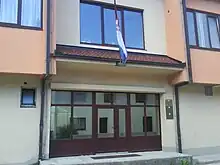
The Cantonal Assembly (Croatian: Županijska skupština, Bosnian and Serbian: Kantonalna skupština/Кантонална скупштина) is the parliament of the Canton 10. It consists of 25 representatives elected by proportional representation for four-year terms of office.
| Political party | Assembly members | ||||||||||
|---|---|---|---|---|---|---|---|---|---|---|---|
| 2002 | 2006 | 2010 | 2014 | 2018 | 2022 | currently | |||||
| Croatian National Shift (HNP) | - | - | - | - | - | 5 | 5 / 25 | ||||
| Croatian Democratic Union (HDZ BiH) | 13 | 5 | 9 | 9 | 8 | 5 | 5 / 25 | ||||
| Croatian Democratic Union (HDZ 1990) | - | 6 | 4 | 4 | 4 | 4 | 4 / 25 | ||||
| Alliance of Independent Social Democrats (SNSD) | 3 | 5 | 3 | 3 | 3 | 2 | 2 / 25 | ||||
| Croatian Independent List (HNL) | - | - | - | 2 | 3 | 2 | 2 / 25 | ||||
| Party of Democratic Action (SDA) | 2 | 2 | 2 | 2 | 2 | 2 | 2 / 25 | ||||
| Social Democratic Party (SDP BiH) | 1 | 1 | 1 | 1 | 1 | 2 | 2 / 25 | ||||
| Serbian Progressive Party FBiH (SNS) | - | - | - | - | 1 | 1 | 1 / 25 | ||||
| Serb National Movement | - | - | - | - | - | 1 | 1 / 25 | ||||
| Croatian Republican Party (HRS) | - | - | - | - | 1 | 1 | 1 / 25 | ||||
| Sources:[13][14][15][16] | |||||||||||
Demographics
.jpg.webp)
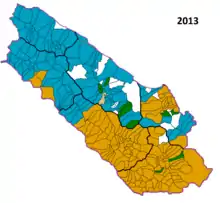

According to the 1991 census, 115.682 people inhabited the canton. Croats comprised 51.5%, Serbs comprised 35.7% and Bosnian Muslims comprised 10.4% of the population. Croats overwhelmingly lived in the southeastern part of the canton (Livno, Kupres, Tomislavgrad), while Serbs lived in northwestern (Grahovo, Glamoč, Drvar). There was a significant population migration during the war (1992–95). In 1992, Serb forces captured Kupres and the surrounding area, pushing away most of the non-Serb population. Croats returned at the end of 1994, after their forces have retaken Kupres. After Croat forces captured Grahovo, Glamoč and Drvar in the summer and fall of 1995, most of the Serb population fled. Refugee Croats from other parts of Bosnia and Herzegovina (fleeing Serb or Bosniak forces) settled in the abandoned area previously inhabited by the Serbs. After the war, under UN and peace implementation forces' pressure, Serb refugees returned to their homes.
In 2013, Canton's population included approximately 77% Croats, 13% Serbs and 9.6% Bosniaks; all other ethnicities combined made up the remaining <0.4%. Canton 10 had the largest share of ethnic Serbs in the Federation of Bosnia and Herzegovina. However, their number has steadily decreased since the conclusion of the Bosnian War.
1991 Census
| Municipality | Nationality | Total | |||||||
|---|---|---|---|---|---|---|---|---|---|
| Croats | % | Serbs | % | Muslims | % | Other | % | ||
| Livno | 29,324 | 72.22 | 3,913 | 9.63 | 5,793 | 14.26 | 1,570 | 3.87 | 40,600 |
| Tomislavgrad | 25,976 | 86.56 | 576 | 1.91 | 3,148 | 10.49 | 309 | 1.02 | 30,009 |
| Glamoč | 184 | 1.46 | 9,951 | 79.02 | 2,257 | 17.92 | 201 | 1.58 | 12,593 |
| Kupres | 3,812 | 43.19 | 4,081 | 46.23 | 802 | 9.08 | 131 | 1.47 | 8,826 |
| Bosansko Grahovo | 226 | 2.71 | 7,888 | 94.91 | 12 | 0.14 | 185 | 2.22 | 8,311 |
| Drvar | 31 | 0.20 | 14,846 | 96.76 | 29 | 0.18 | 437 | 2.86 | 15,343 |
| Canton | 59,553 | 51.48 | 41,255 | 35.66 | 12,041 | 10.41 | 2,833 | 2.45 | 115,682 |
2013 Census
| Municipality | Nationality | Total | |||||||
|---|---|---|---|---|---|---|---|---|---|
| Croats | % | Serbs | % | Bosniaks | % | Other | % | ||
| Livno | 29,273 | 85.76 | 438 | 1.28 | 4,047 | 11.85 | 216 | 0.63 | 34,133 |
| Tomislavgrad | 29,006 | 91.81 | 22 | 0.06 | 2,467 | 7.80 | 30 | 0.09 | 31,592 |
| Glamoč | 906 | 23.47 | 1,679 | 43.49 | 1,251 | 32.40 | 13 | 0.33 | 3,860 |
| Kupres | 4,474 | 88.47 | 318 | 6.28 | 255 | 5.04 | 5 | 0.09 | 5,057 |
| Bosansko Grahovo | 393 | 16.04 | 2,028 | 82.80 | 6 | 0.24 | 10 | 0.40 | 2,449 |
| Drvar | 552 | 7.85 | 6,420 | 91.24 | 11 | 0.15 | 24 | 0.34 | 7,036 |
| Canton | 64,604 | 76.79 | 10,905 | 12.96 | 8,037 | 9.55 | 581 | 0.69 | 84,127 |
Economy
_Touristic_Map.png.webp)
The canton has significant natural resources, with large reserves of coal and timber, as well as hydro & wind power. Due to economic reasons (insufficient canton revenues compared to expenses) unification with West Herzegovina Canton has been proposed.[17][18]
The pre-war economic recession, and certainly the war in this area, caused significant population fluctuations in the form of emigration to Western European countries or relocation to other areas of Bosnia and Herzegovina.
The natural and geographical features of this area are diverse, from fertile and vast fields and vast pastures, rivers and lakes to centuries-old deciduous and evergreen forests, and provide abundant opportunities for life and economic development based on agricultural production, livestock and the timber industry. The ecologically clean and intact nature, the temperate continental climate, the geographical position and the proximity and good transport connections with other parts of Bosnia and Herzegovina and neighboring Croatia, especially Dalmatia, which traditionally and economically gravitate, are important factors for the economic development of this area. The canton suffered severe damage during the last war and is one of the worst affected areas in the Federation of Bosnia and Herzegovina. The rebuilding process is slow and difficult, but the economy is already showing signs of recovery, mainly visible in the construction, wood processing industry, small business and handicrafts segment. Although commerce is still the dominant branch of the economy, in terms of the total number of companies (191 or 44.50% of the total of 429 active companies and 30% of total income).
Viewed from the revenue aspect of 1998 and 1999, there was a significant increase in construction, agriculture and forestry, as well as transportation, industry and mining. Commerce registered a decrease in income compared to 1998 by 2 index points, as well as a decrease in the participation in total income at the cantonal level from 44.80% in 1998 to 30% in 1999 in favor of other productive activities, and especially construction agriculture and forestry, especially if we take into account that the total income generated at the cantonal level in 1999 increased by 25% compared to 1998. All these are positive indicators of economic recovery and the basis of the expected future development.
The main economic branches of Canton 10 according to the number of employees are the wholesale and retail trade, the processing industry and agriculture, forestry and fishing.[19]
The average salary in Canton 10 is 840 km (2014). The highest average net salary is paid in Bosanski Grahovo (986 km) and the lowest in Tomislavgrad (766 km).
See also
References
- Sarajevo, juni 2016. CENZUS OF POPULATION, HOUSEHOLDS AND DWELLINGS IN BOSNIA AND HERZEGOVINA, 2013 FINAL RESULTS (PDF). BHAS. Archived from the original (PDF) on 24 December 2017. Retrieved 30 June 2016.
- "U-11/97". Archived from the original on 19 April 2008. Retrieved 8 June 2009.
- "hbzup.com". www.hbzup.com. Archived from the original on 16 July 2007. Retrieved 6 April 2018.
- "Vlada Hercegbosanske županije". www.vladahbz.com. Retrieved 6 April 2018.
- "Utopio se pijan plivajući u Buškom jezeru". sarajevo-x.com. Retrieved 6 April 2018.
- "mediainfo.ba - Livanjski kanton: Do 2010. godine biće izgrađene prve vjetrenjače". mediainfo.ba. Archived from the original on 1 February 2009. Retrieved 6 April 2018.
- "24sata.info - Livanjski kanton: Ministar zdravlja Darko Horvat lomio po kafani!". 24sata.info. Archived from the original on 28 July 2011. Retrieved 6 April 2018.
- "Ustav - Vlada Hercegbosanske županije" (PDF). Vlada Hercegbosanske županije. 12 October 2005. p. 3.
- "Naslovna - Ministarstvo unutranjih poslova Kantona 10". www.mupk10.gov.ba (in Croatian and Bosnian). Ministarstvo unutarnjih poslova K10. Retrieved 19 July 2018.
- "Sporna obilježja na grbovima BiH". Al Jazeera Balkans. 23 April 2015.
- "OSNOVNE INFORMACIJE, KANTON 10". Archived from the original on 13 May 2010. Retrieved 8 November 2009.
- (in Bosnian and Croatian) "PRELIMINARY RESULTS Of the 2013 Census of Population, Households and Dwellings in Bosnia and Herzegovina" (PDF). www.bhas.ba/. Agency for Statistics of Bosnia and Herzegovina. 5 November 2013. Archived from the original (PDF) on 23 November 2018. Retrieved 28 January 2014.
- "Verified results of the 2010 general elections: The Cantonal Assemblies in the Federation of Bosnia and Herzegovina: Canton 10". izbori.ba. Central Election Commission of Bosnia and Herzegovina. Archived from the original on 5 November 2010. Retrieved 30 May 2013.
- "210-Skupština kantona 10 (210-Assembly of Canton 10)". izbori.ba (in Bosnian). Central Election Commission of Bosnia and Herzegovina. Retrieved 30 May 2013.
- "Opći izbori-konačni rezultati (General elections-final results)" (PDF). izbori.ba (in Croatian). Central Election Commission of Bosnia and Herzegovina. Retrieved 30 May 2013.
- "Opći izbori-konačni rezultati (General elections-final results)". izbori.ba. Central Election Commission of Bosnia and Herzegovina. Retrieved 24 October 2018.
- "Đokoviću pobjeda donosi svjetski tron". Archived from the original on 6 July 2011. Retrieved 28 July 2009.
- Monitor – portal za svaki dan – Offline
- "Kanton 10 u brojkama (Canton 10 in numbers)" (PDF). Archived (PDF) from the original on 22 July 2018.
